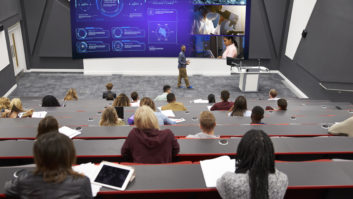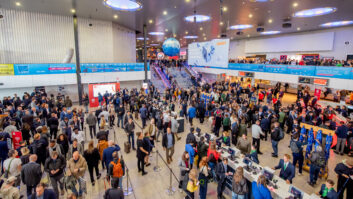Futuresource Consulting’s IBC2025 analysis reveals that this year’s event was defined by broadcast’s accelerating convergence with pro AV, the adoption of AVoIP, expanded system interoperability, and emerging AI applications – all themes with strong implications for pro AV integrators operating at the intersection of broadcast and AV.
The report also says that IBC2025 had 43,858 visitors, a 2.7 percent year-on-year (YoY) decrease compared to 2024. The analysis suggests that IBC attendance has never recovered to pre-pandemic levels, with the 2025 attendance 22 percent lower than that in 2019. The show had more than 1300 exhibitors, a 3.5 percent YoY drop.
 Futuresource says the decreasing attendance is due to a multitude of factors, such as shrinking budgets from broadcasters to purchase equipment, the cost of hosting a stand, as well as competition from other trade shows such as ISE and InfoComm, particularly as vendors explore opportunities beyond traditional broadcast.
Futuresource says the decreasing attendance is due to a multitude of factors, such as shrinking budgets from broadcasters to purchase equipment, the cost of hosting a stand, as well as competition from other trade shows such as ISE and InfoComm, particularly as vendors explore opportunities beyond traditional broadcast.
The report outlines the major themes to emerge from the show:
Technology convergence
Technology convergence between traditional broadcast and non-traditional applications continues to trend. Large sensor pro PTZ cameras allow broadcasters to achieve the “cinematic look” at a lower cost. Comparatively, broadcast technology vendors are increasingly launching solutions catered towards non-broadcast end-users, while allowing them to achieve a “broadcast look”.
AVoIP adoption
The analysis reveals that AVoIP adoption is accelerating as broadcasters seek scalable, cost-effective alternatives to traditional SDI workflows. Vendors demonstrated hybrid SDI/IP systems, low-latency streaming, and plug-and-play converters that simplify deployment and reduce disruption.
AVoIP is also enabling innovation in control surfaces, with modular, IP native interfaces supporting centralised management of cameras, lighting, and media systems across broadcast, corporate AV, and industrial sectors.
Interoperability
Futuresource says interoperability was a major theme at the show, and it was highlighted through the demonstration of “Media Exchange Layers” (MXLs). MXLs offer a shared memory platform, and act as a bridge to help different media technologies, even from different vendors, speak the same language. This enables seamless collaboration across diverse tools and vendors, supporting “best-of-breed” workflows and reducing vendor lock-in. This modular approach is key to building scalable, cloud-ready production environments.
AI innovation
AI innovation took centre stage, particularly with the rise of agentic AI, autonomous systems that streamline media asset management, content creation, and quality control. These tools are reshaping workflows by automating repetitive tasks and enhancing productivity. Ethical concerns around deepfakes and misinformation were also addressed, with vendors integrating content provenance standards like C2PA to ensure authenticity.
Overall, IBC 2025 reflected an industry embracing flexibility, intelligence, and interoperability, laying the foundation for a more agile and inclusive future in media production and distribution.
To download the free report click here.







